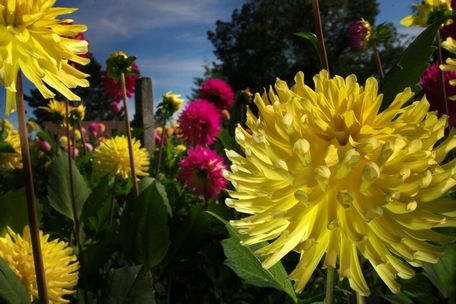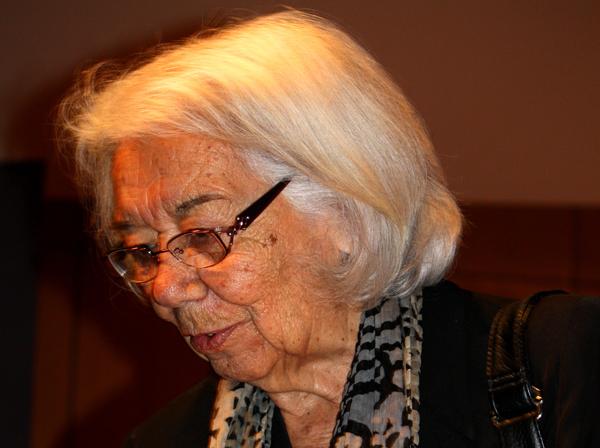
Bernie Wilson of Snohomish won the Stanley Johnson Medal, a national award, for his dahlia called Lakeview Glow.
Andrea Brown, The Herald
If fireworks were flowers they’d be dahlias.
The big bursts of color light up a garden like a July 4th celebration.
And they stay lit until the first frost.
Dahlias are colossal flowers. Some are the size of pumpkins
Growers will show off their blooms at this weekend’s Snohomish County Dahlia Show in Everett. It is the club’s 104th consecutive year to have a show.
“We’ve had as many as 2,200 or 2,300 blooms,” said Hills Collins, show spokesman.
The judging is done before the doors open to the public.
“We have a head table with all the different winners,” Collins said. “The head table is judged to pick the best flower in the show. All different types are judged against each other, and one bloom is picked.”
Club members will be on hand to answer questions and talk about their blooms.
Longtime member Bernie Wilson, 68, a retired Snohomish firefighter, won the prestigious national Stanley Johnson Medal in 2012 for Lakeview Glow, an incurved cactus dahlia he originated.
The lake part is named after Blackmans Lake that is the backdrop to his 5-acre Snohomish property.
“The ‘glow’ came from if you stand up there by the house and look over the garden down it kind of glows up from all the rest of them,” he said.
His yard is aglow with about 100 varieties of dahlias.
“It’s just a fun hobby. It’s a challenge to show them. I enjoy being outside and in the garden, so it kind of comes natural,” he said.
He started growing dahlias in the 1970s after a neighbor gave him a tuber. Dahlia plants grow from tubers planted in the ground like potatoes.
From the ugly duckling roots come gorgeous blooms.
On show days, Wilson takes the best blooms he cuts to competitions and leaves the rest out for his neighbors to fill their vases. “Saturday morning they’re on the carport. And anybody who wants them can come get them,” he said.
Allison Richards also likes to spread the dahlia love around, in various forms.
“I give people at my work a bunch of tubers, and they just go nuts,” said Richards, 42, IT and general services manager at Maple Systems.
She started out growing a few dahlias and now has about 60 to 70 varieties and 200 plants.
“I threw myself into it; let’s put it that way,” she said. “I tie it in with my photography hobby. I put together a dahlia calendar for family and friends. The colors are so vibrant. There are so many different varieties and shapes and sizes.”
Dahlias are her tonic.
“I work with computers. Things break. Things don’t always go the way they should,” she said.
“I go home and go out there and there’re pretty flowers.”
See the show
The Snohomish County Dahlia Show is from 1 to 6 p.m. on Saturday and 10 a.m. to 4 p.m. Sunday, at Floral Hall at Forest Park, 802 Mukilteo Blvd., Everett.
Cost: Free.
For more information, visit www.scdahlias.org or call 360-659-8687.
Snohomish County Dahlia Society meetings are 7 p.m. on the second Thursday of the month at Legion Park Hall, 145 Alverson Blvd., in Everett. The club has a tuber sale in April.
Caring for dahlias
In summer:
- Remove old or spent flowers.
- Water deeply every four or five days during the summer heat.
- As the blooms develop, fertilize with a low or no nitrogen fertilizer, such as one labeled 0-20-20, to encourage flower and tuber development.
- Control for slugs, snails and other pests.
- Remove two side buds at each budding tip to encourage better blooms.
Digging dahlias:
- Enjoy the flowers until the first frost kills the foliage.
- If you have good drainage, leave the tubers in the ground, cut off any dead foliage, and cover with 3 to 4 inches of mulch. Clumps should be divided every third year for bigger, better flowers and stronger stems.
- If you choose to dig the tubers, cut off the stalks to 3 or 4 inches above the ground and leave in the ground for a week or two to allow eyes to set before digging. Begin cutting down and digging by November even if no killing frost has taken place.
- Dig around each tuber clump with a shovel or garden fork and lift gently. Hose off the dirt from the tuber, clip off the feeder roots with garden scissors and let dry overnight.
Dividing and storing:
- Divide clumps in half by splitting with pruning shears.
- Cut off tubers using hand pruners, garden scissors and a sharp knife. Wear protective gloves. Each tuber should have an eye you can see. The tuber eyes are located at the swell of the crown near the stem.
- Soak tubers in a solution of 1 cup of bleach and 3 gallons of water for 15 or 20 minutes to kill bacteria. Allow tubers to dry several days on newspaper in a cool, dark place.
- Label the tubers before storing with a permanent marker or no-blot pencil. If you don’t know the name, just list the flower color.
- Store cut tubers in plastic bags with a few handfuls of vermiculite, wood shavings or potting soil. Another method is rolling tubers in a long strip of plastic wrap, making sure each tuber isn’t touching the others.
- Keep tubers in a dark, cool place that does not freeze. A crawl space, root cellar or old refrigerator are good locations.
Source: The Snohomish County Dahlia Society

















